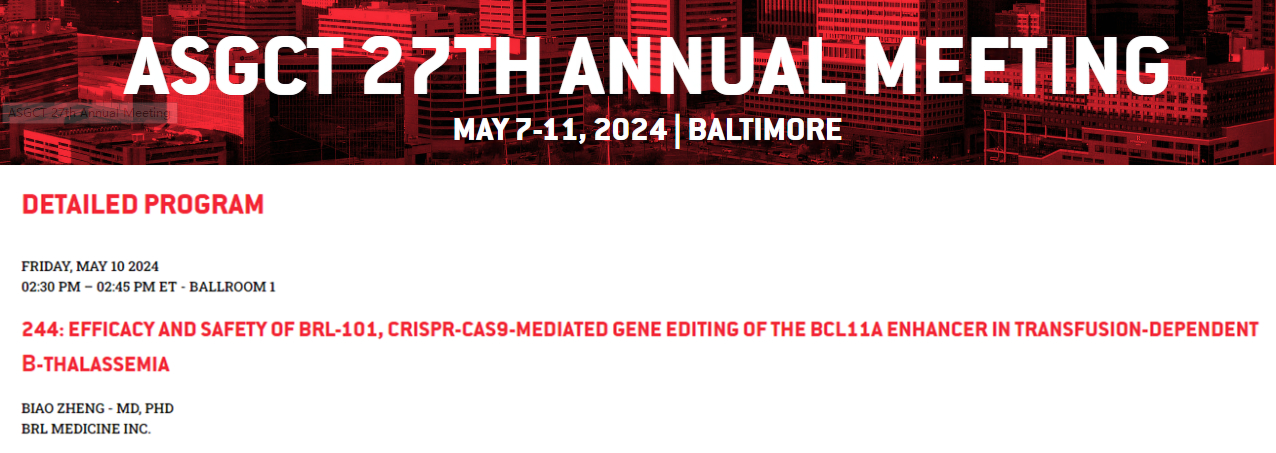

2024-04-25
On April 22,2024 (Eastern Time), the27th American Society for Gene and Cell Therapy Annual Meeting (ASGCT) released online summaries of several of the latest research results selected for this year's conference. We are honored to announce that the gene therapy product "BRL-101 Autologous Hematopoietic Stem and Progenitor Cell Injection" (Pipeline Code: BRL-101), developed by BRL Medicine for transfusion-dependent β-thalassemia based on its independently developed hematopoietic stem cell platform (ModiHSC®), has been successfully selected for the ASGCT annual meeting for the second consecutive year. The latest clinical progress data will be presented in the form of an oral report.
The ASGCT annual meeting is scheduled to take place from May7th to 11th,2024 (Eastern Time). Dr. Biao Zheng, CEO of BRL Medicine, will attend the offline meeting to share and exchange new gene editing technologies and expertise with domestic and international experts and scholars in the field of CGT. The clinical potential and application prospects of cell therapy will also be discussed.

About BRL-101
On August 16, 2022, the clinical trial application (IND) of BRL Medicine's BRL-101 was officially approved by the Center for Drug Evaluation (CDE) of the China National Medical Products Administration, entering the registration clinical stage. Its primary indication is transfusion-dependent beta-thalassemia, developed as a gene therapy product based on the independently developed hematopoietic stem cell platform (ModiHSC®) by BRL Medicine. ModiHSC® primarily utilizes a gene editing system to genetically modify the patient's hematopoietic stem cells. The modified cells are then reintroduced into the patient's body to rebuild the cell population through self-renewal and differentiation, effectively treating hematological diseases. Currently, BRL Medicine's gene therapy, BRL-101, has successfully enabled 15 thalassemia patients worldwide to become independent of blood transfusions.
The results of the IIT and IND Phase 1 clinical studies of BRL-101 were announced at this meeting. The study, conducted in China, evaluated "gamma globin reactivated autologous hematopoietic stem cell transplantation for the treatment of β-thalassemia major (Thalassemia) safety and effectiveness." A total of 15 patients aged 6-26 years were enrolled in the study. The clinical results indicated a significant increase in overall Hb and HbF levels after all patients received gene-edited HSC transplantation. Throughout the treatment process, most adverse events were consistent with known adverse events for hematopoietic stem cell mobilization/apheresis, busulfan myeloablative conditioning, and autologous hematopoietic stem cell transplantation. All adverse events could be resolved with medical intervention, and the vast majority of adverse events were resolved. There were no cases of GVHD, subject withdrawal from the study, or deaths due to adverse events. This study demonstrates that BRL-101:
1. Better treatment effect
All 15 patients who received BRL-101 gene therapy were 100% free of blood transfusion dependence and achieved lifelong cure after one treatment! At the same time, the average total hemoglobin of patients is greater than 120g/L and quickly returns to the level of healthy people. The therapeutic effects are significantly better than those of foreign marketed products and domestic products under development.
2. Higher security
BRL Medicine's BRL-101 product uses electroporation to deliver gene editing materials, which avoids safety issues caused by random insertion of viral vector-based cell gene therapy products. At the same time, the target of gene editing has undergone a large number of off-target studies, proving that the target has no off-target effects and has high safety.
Generally speaking, compared with other gene therapies, BRL Medicine's BRL-101 gene therapy is more efficient, convenient and safe. It has the advantages of good targeting, high safety, wide range of action and significant therapeutic effect. It can do One treatment provides lifelong cure, which is expected to become a more beneficial treatment for the public.